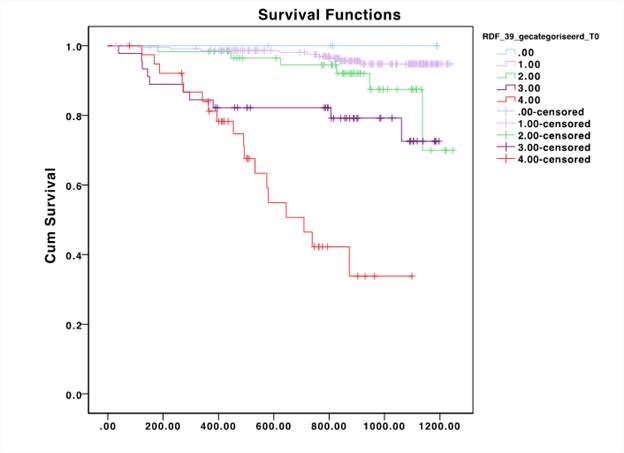Degree Of Sensory Loss Predicts Risk For Ulceration In Diabetic Patients
Willem D. Rinkel, MD1,2; Erwin Birnie, PhD2; Manuel Castro Cabezas, MD, PhD2; J Henk Coert, MD, PhD1,2
1Utrecht University Medical Center, Utrecht, Netherlands, 2Franciscus Gasthuis & Vlietland, Rotterdam, Netherlands
Introduction
The loss of sensation diabetic patients are confronted with due to neuropathy can be graded precisely. The screening instruments from the 39-item Rotterdam Diabetic Foot (RDF) Study Test Battery can validly categorize the sensation in patient's feet in the following categories: no loss of sensation, loss of two-point discrimination, loss of vibration sense, loss of protective sensation or severe loss of sensation. We investigated the relationship between degree of sensory loss and risk for diabetic foot ulceration in a cohort of patients with diabetes.
Materials and Methods
Patients without and with symptoms of neuropathy participating in the prospective RDF Study were followed for three years. Subjects underwent sensory testing of the feet annually using the RDF Study Test Battery. Patients at baseline were categorized in one of five categories of incremental sensory loss. Data on incident diabetic foot ulceration were collected annually. Ulceration rates at three-year follow-up were estimated with Kaplan-Meier survival analysis. Events were diagnosed as the occurrence of an ulcer and time to event was time to diagnosis of ulcer.
Results
Of the 416 patients studied, 1.4% had no loss of sensation (Group 0), 59.9% lost two-point discrimination (Group 1), 15.6% lost vibration sense (Group 2), 12.7% lost protective sensation (Group 3) and 10.3% had severe sensory loss (e.g. aberrant cold sensation) (Group 4) at baseline. The median follow-up was 871.5 days (IQR: 579.8 to 1095.5), including survivors and patients who died during the study period. Forty-three ulcers developed during follow-up; Group 0: n=0 (0%), Group 1: n=9 (3.6%), Group 2: n=6 (9.2%), Group 3: n=10 (18.9%) and Group 4: n=18 (41.9%). Three-year ulceration rates were significantly higher for the groups with more severe sensory loss (p < .0001), see Figure 1.
Conclusions
The degree of sensory loss at baseline was associated with progression to diabetic foot ulceration during follow-up. Grading the loss of sensation using the RDF Study Test Battery may improve the current screening of the feet at risk and support the stratification of patients at risk, aiding clinical decision making.
Disclosure: none to declare.
Back to 2019 ePosters
